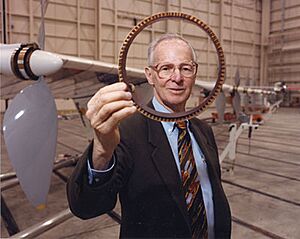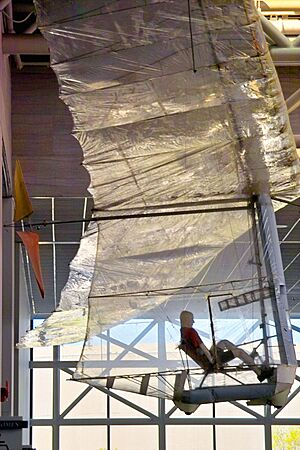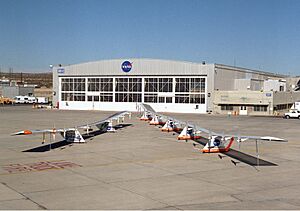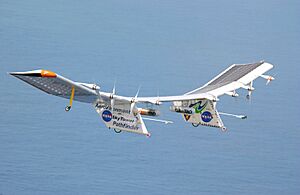AeroVironment facts for kids
 |
|
| Public | |
| Traded as |
|
| Industry |
|
| Founded | 1971 |
| Founder | Paul B. MacCready Jr. |
| Headquarters | Arlington, Virginia, U.S. |
| Revenue | |
|
Operating income
|
|
| Total assets | |
| Total equity | |
|
Number of employees
|
1,214 (2022) |
AeroVironment, Inc. is an American company that designs and builds special aircraft. These aircraft are called unmanned aerial vehicles (UAVs), or drones. The company is based in Arlington, Virginia.
Paul B. MacCready Jr. started AeroVironment in 1971. He was famous for designing planes powered by humans. AeroVironment is well-known for its light planes. These planes are powered by humans or by the sun. The company is a top supplier of small drones for the U.S. military. Some of their famous drones include the Raven, Switchblade, Wasp, and Puma.
Contents
Company History
AeroVironment has faced some challenges. On January 7, 2024, the Chinese government placed sanctions on AeroVironment. This was due to U.S. arms sales to Taiwan. Later, on March 4, 2025, the Chinese Ministry of Commerce added AeroVironment to its export control list. This means certain items cannot be exported to the company.
Amazing Vehicles
AeroVironment has built many incredible vehicles. Here are some of them:
- Gossamer Condor – This was the first airplane powered only by a human. It won the first Kremer Prize in 1977. You can see it at the U.S. National Air and Space Museum (NASM).
- Gossamer Albatross – In 1979, this human-powered plane flew 23 miles (37 km) across the English Channel. It won a huge prize in aviation history. Another one is at the National Air and Space Museum.
- Gossamer Penguin – This plane was a version of the Gossamer Albatross. It was powered by the sun.
- Solar Challenger – This plane flew 163 miles (262 km) from Paris, France, to England. It used only solar power.
- High Altitude Solar (HALSOL) – The CIA supported this solar-powered drone in the 1980s. It was an early unmanned solar aircraft for national security. It later became the Pathfinder.
- NASA Pathfinder and Pathfinder Plus – AeroVironment built this unmanned plane for NASA. It showed that a plane could fly for a long time using solar power. The Pathfinder was later rebuilt into the larger Pathfinder Plus. It is now on display at NASM.
- NASA Centurion – This plane was an improved Pathfinder. It was designed to fly very high, at 100,000 feet (30,000 m).
- NASA Helios Prototype – This UAV used solar cells and fuel cells. It set a world record by flying at 96,863 feet (29,524 m). It was meant to be an "atmospheric satellite."
- Global Observer – This drone made its first flight in January 2011. It is powered by hydrogen. It has a 175-foot (53 m) wingspan and can fly for 5 to 7 days.
- Sunraycer – This solar-powered car won the first solar car race in Australia in 1987. The next car finished two days later! This car is at the Smithsonian National Museum of American History.
- GM Impact – This was an electric car. It was a test model for a car that could be mass-produced.
- RQ-11 Raven – This is a small military drone. Soldiers can launch it by hand. It weighs 4.2 pounds (1.9 kg) and has a 4.5 feet (1.4 m) wingspan. It sends video to a handheld control station.
- Wasp III – This is a tiny, hand-launched drone. It can observe areas up to 3.1 miles (5.0 km) away. The U.S. Air Force chose it for their BATMAV Program in 2007.
- RQ-20 Puma – This is a small, light, battery-powered drone. It is launched by hand. It can observe areas up to 6.2 miles (10.0 km) away. It can fly itself using GPS navigation.
- Nano Hummingbird – This drone was announced in 2011. It looks like a hummingbird and has a camera. It can fly in all directions and rotate.
- SkyTote – This drone can take off and land vertically. It also has fixed wings for efficient flight.
- Switchblade – This is a small, electric, armed drone. It is a "kamikaze" weapon for use in the field. There are two versions: the 300 for attacking people and the 600 for attacking armored vehicles.
- FQM-151 Pointer
- RQ-14 Dragon Eye
- Puma LE (Long Endurance)
- VAPOR Helicopter
- Shrike – This is a quadrocopter drone. It is designed for "perch and stare" surveillance. It weighs 5 lb (2.27 kg) and can hover for 40 minutes.
- Snipe – This is a small quadrotor drone. It is small enough for one person to use for surveillance. It weighs 5 oz (0.14 kg) and can fly up to 20 mph (32 km/h). It has a range of over 0.6 mi (0.97 km).
- Quantix – This drone has a 40 kilometres (25 mi) range and can fly for 45 minutes. It weighs 2.3 kilograms (5.1 lb) and is controlled by encrypted radio.
- Red Dragon – This is a "loitering munition" designed for autonomous attacks. It weighs 45 lb (20 kg) and has a range of 250 mi (400 km).
Special Programs
In 2007, AeroVironment had a contract with the U.S. Air Force Research Laboratory. This contract was to develop new technologies for drone propulsion. This included putting solar cells into wings and improving electric motors.
In 2023, Israel asked the U.S. Department of Defense for 200 Switchblade 600 attack drones. As of August 2025, it is not clear if this request was approved.
HAPSMobile Partnership
HAPSMobile is a company that plans to use special aircraft for telecommunications. AeroVironment owns a small part of HAPSMobile. HAPSMobile is developing the Hawk30. This is a solar-powered drone for communication in the stratosphere. They also work with Loon LLC, which is part of Google's parent company, Alphabet Inc..
Other Companies Owned
AeroVironment owns Skytower, Inc. This company was started in 2000. It works on using high-altitude drones as "atmospheric satellites." These drones can act like communication towers high in the sky.
In July 2002, the NASA/AeroVironment UAV Pathfinder Plus carried Skytower's communication equipment. This tested using the aircraft as an "atmospheric satellite." Skytower, NASA, and the Japan Ministry of Telecommunications used the aircraft. They sent an HDTV signal and a wireless signal from 65,000 ft (20,000 m). This was like having a 12 mi (19 km) tall transmitter tower.
In January 2021, AeroVironment bought Arcturus UAV. Arcturus UAV makes the Arcturus T-20 drone. AeroVironment paid US$405 million for the company.





